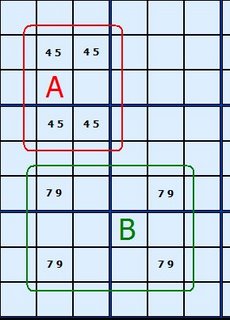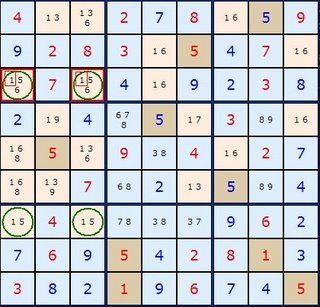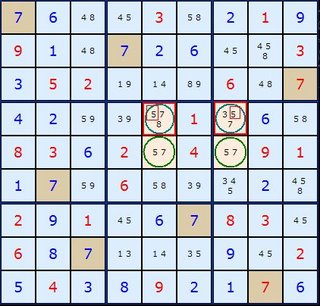This strategy is based on extending Aligned Pair Exclusion but uses Almost Locked Sets to make some clever reductions. From the components used it could be named Aligned ALS Exclusion but Mike Barker, who formulated it first in this thread, hit on "Death Blossom" because it starts with a cell designated as the "stem" which points to Almost Locked Sets, or the "petals", and is a great deal more flowery.
An Almost Locked Set is any group of N cells (that can all see each other) with N+1 candidates between them . This includes bi-value cells. A Locked Set, by contrast, contains exactly the right number of canidates for the group, examples of which are Naked Pairs and Triples.

To get a feel for what’s going it worth working backwards from the elimination of 1 in E1 in this first example. We have two Almost Locked Sets {D2,F2,H2} and {E5,E8,E9} and they both have 1 as a common number between them. If E1 did have 1 as a solution it would reduce the first Almost Locked Set to a Naked Pair with 2/4 forcing H2 to be 8. The second ALS would also reduce to a Naked Pair of 7/9 forcing E9 to be 2. If E9 is 2 and H2 is 8 then the stem cell (coloured green) H9 is left with nothing. This confirms that E1 is not 1.
If we work forwards from the “stem” cell we’ll get closer to a formula for finding this formation. H9 with {2/8} must be able to see at least two ALSs which contain all its candidates. It is important that the 2 in H9 can see all of the 2’s in the brown coloured ALS (one instance in this case) and 8 in H9 can see all of the 8’s in the yellow coloured ALS (also one in this instance). But H9 overall does not have to see every single cell in all the ALSs, just the cells it shares candidates with.
Now, the two ALSs must have a candidate Z in common which the "stem" cell does not have. Because ALSs contain exactly one extra candidate for the number of cells they occupy (the N+1 candidates for N cells rule), we can assert that ANY cell that can see all the Zs in both ALS but is not part of those ALSs or the stem cell can be removed. Such a cell is E1.
Death Blossom was discovered by extending Aligned Pair Exclusion (APE) and asking if there was generalization beyond the pairs and triples discussed in Aligned Pair Exclusion. With Almost Locked Sets there is. The stem cell H9 and the elimination cell E1 can’t see each other – they not aligned, but the pairs they can make do affect the board. In our example, consider the pairs that can be made between the 1 in E1 and the 2/8 in H9. These are 1/2 and 1/8 in E1 and H9 respectively. Both these turn out to be illegal since they would reduce our ALSs to having less candidates than cells. So whatever the solutions to the two disparate cells E1 and H9, E1 will never contain a 1.

In Figure 2 quite a different arrangement is apparent but the logic is identical. The two yellow coloured cells form a two-cell ALS with the values {1/2/8}. At the bottom there is a four-cell ALS with {3/4/7/8/9}. Our stem cell again contains only two candidates {1/4} (coloured green) but don't think this is a restriction. There could be five or six numbers in the stem cell. As long as there are sufficient Almost Locked Sets that the candidates can see then the pattern can be made to work.
There is another way to look at this example which mirrors some strategies already covered. Starting in H8
If H8 is 1 -> B8=2 -> B2=8 therefore A3,B3,C3,J2 <> 8
If H8 is 4 -> H1=7 -> H2=9 -> H3=3 -> J3=8 therefore A3,B3,C3,J2 <> 8
When traced through in this manner Death Blossom doesn’t seem so daunting.
Go To : Basic Fishy Advanced
Go To : Sudoku solving techniques








